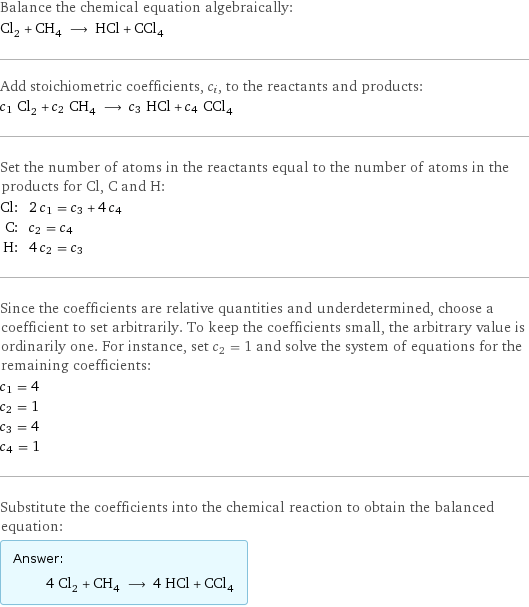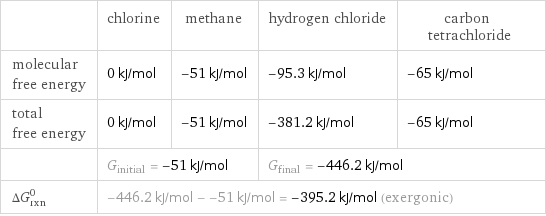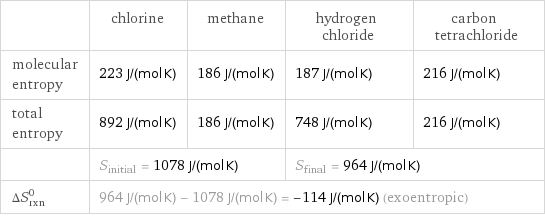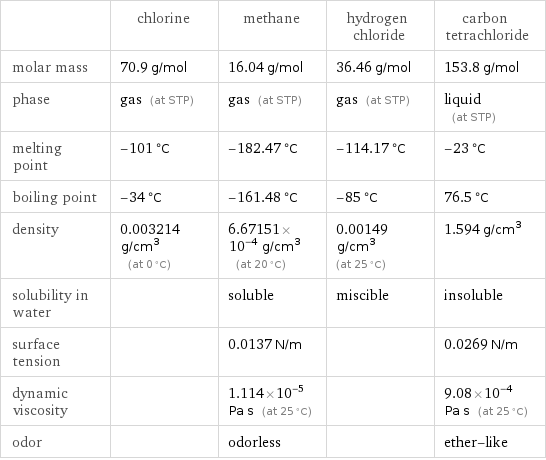Input interpretation

Cl_2 (chlorine) + CH_4 (methane) ⟶ HCl (hydrogen chloride) + CCl_4 (carbon tetrachloride)
Balanced equation

Balance the chemical equation algebraically: Cl_2 + CH_4 ⟶ HCl + CCl_4 Add stoichiometric coefficients, c_i, to the reactants and products: c_1 Cl_2 + c_2 CH_4 ⟶ c_3 HCl + c_4 CCl_4 Set the number of atoms in the reactants equal to the number of atoms in the products for Cl, C and H: Cl: | 2 c_1 = c_3 + 4 c_4 C: | c_2 = c_4 H: | 4 c_2 = c_3 Since the coefficients are relative quantities and underdetermined, choose a coefficient to set arbitrarily. To keep the coefficients small, the arbitrary value is ordinarily one. For instance, set c_2 = 1 and solve the system of equations for the remaining coefficients: c_1 = 4 c_2 = 1 c_3 = 4 c_4 = 1 Substitute the coefficients into the chemical reaction to obtain the balanced equation: Answer: | | 4 Cl_2 + CH_4 ⟶ 4 HCl + CCl_4
Structures

+ ⟶ +
Names

chlorine + methane ⟶ hydrogen chloride + carbon tetrachloride
Reaction thermodynamics
Gibbs free energy

| chlorine | methane | hydrogen chloride | carbon tetrachloride molecular free energy | 0 kJ/mol | -51 kJ/mol | -95.3 kJ/mol | -65 kJ/mol total free energy | 0 kJ/mol | -51 kJ/mol | -381.2 kJ/mol | -65 kJ/mol | G_initial = -51 kJ/mol | | G_final = -446.2 kJ/mol | ΔG_rxn^0 | -446.2 kJ/mol - -51 kJ/mol = -395.2 kJ/mol (exergonic) | | |
Entropy

| chlorine | methane | hydrogen chloride | carbon tetrachloride molecular entropy | 223 J/(mol K) | 186 J/(mol K) | 187 J/(mol K) | 216 J/(mol K) total entropy | 892 J/(mol K) | 186 J/(mol K) | 748 J/(mol K) | 216 J/(mol K) | S_initial = 1078 J/(mol K) | | S_final = 964 J/(mol K) | ΔS_rxn^0 | 964 J/(mol K) - 1078 J/(mol K) = -114 J/(mol K) (exoentropic) | | |
Equilibrium constant
![Construct the equilibrium constant, K, expression for: Cl_2 + CH_4 ⟶ HCl + CCl_4 Plan: • Balance the chemical equation. • Determine the stoichiometric numbers. • Assemble the activity expression for each chemical species. • Use the activity expressions to build the equilibrium constant expression. Write the balanced chemical equation: 4 Cl_2 + CH_4 ⟶ 4 HCl + CCl_4 Assign stoichiometric numbers, ν_i, using the stoichiometric coefficients, c_i, from the balanced chemical equation in the following manner: ν_i = -c_i for reactants and ν_i = c_i for products: chemical species | c_i | ν_i Cl_2 | 4 | -4 CH_4 | 1 | -1 HCl | 4 | 4 CCl_4 | 1 | 1 Assemble the activity expressions accounting for the state of matter and ν_i: chemical species | c_i | ν_i | activity expression Cl_2 | 4 | -4 | ([Cl2])^(-4) CH_4 | 1 | -1 | ([CH4])^(-1) HCl | 4 | 4 | ([HCl])^4 CCl_4 | 1 | 1 | [CCl4] The equilibrium constant symbol in the concentration basis is: K_c Mulitply the activity expressions to arrive at the K_c expression: Answer: | | K_c = ([Cl2])^(-4) ([CH4])^(-1) ([HCl])^4 [CCl4] = (([HCl])^4 [CCl4])/(([Cl2])^4 [CH4])](../image_source/395b535e157ff09dbc01711a09264c19.png)
Construct the equilibrium constant, K, expression for: Cl_2 + CH_4 ⟶ HCl + CCl_4 Plan: • Balance the chemical equation. • Determine the stoichiometric numbers. • Assemble the activity expression for each chemical species. • Use the activity expressions to build the equilibrium constant expression. Write the balanced chemical equation: 4 Cl_2 + CH_4 ⟶ 4 HCl + CCl_4 Assign stoichiometric numbers, ν_i, using the stoichiometric coefficients, c_i, from the balanced chemical equation in the following manner: ν_i = -c_i for reactants and ν_i = c_i for products: chemical species | c_i | ν_i Cl_2 | 4 | -4 CH_4 | 1 | -1 HCl | 4 | 4 CCl_4 | 1 | 1 Assemble the activity expressions accounting for the state of matter and ν_i: chemical species | c_i | ν_i | activity expression Cl_2 | 4 | -4 | ([Cl2])^(-4) CH_4 | 1 | -1 | ([CH4])^(-1) HCl | 4 | 4 | ([HCl])^4 CCl_4 | 1 | 1 | [CCl4] The equilibrium constant symbol in the concentration basis is: K_c Mulitply the activity expressions to arrive at the K_c expression: Answer: | | K_c = ([Cl2])^(-4) ([CH4])^(-1) ([HCl])^4 [CCl4] = (([HCl])^4 [CCl4])/(([Cl2])^4 [CH4])
Rate of reaction
![Construct the rate of reaction expression for: Cl_2 + CH_4 ⟶ HCl + CCl_4 Plan: • Balance the chemical equation. • Determine the stoichiometric numbers. • Assemble the rate term for each chemical species. • Write the rate of reaction expression. Write the balanced chemical equation: 4 Cl_2 + CH_4 ⟶ 4 HCl + CCl_4 Assign stoichiometric numbers, ν_i, using the stoichiometric coefficients, c_i, from the balanced chemical equation in the following manner: ν_i = -c_i for reactants and ν_i = c_i for products: chemical species | c_i | ν_i Cl_2 | 4 | -4 CH_4 | 1 | -1 HCl | 4 | 4 CCl_4 | 1 | 1 The rate term for each chemical species, B_i, is 1/ν_i(Δ[B_i])/(Δt) where [B_i] is the amount concentration and t is time: chemical species | c_i | ν_i | rate term Cl_2 | 4 | -4 | -1/4 (Δ[Cl2])/(Δt) CH_4 | 1 | -1 | -(Δ[CH4])/(Δt) HCl | 4 | 4 | 1/4 (Δ[HCl])/(Δt) CCl_4 | 1 | 1 | (Δ[CCl4])/(Δt) (for infinitesimal rate of change, replace Δ with d) Set the rate terms equal to each other to arrive at the rate expression: Answer: | | rate = -1/4 (Δ[Cl2])/(Δt) = -(Δ[CH4])/(Δt) = 1/4 (Δ[HCl])/(Δt) = (Δ[CCl4])/(Δt) (assuming constant volume and no accumulation of intermediates or side products)](../image_source/e9454da40a5c51a5eb9b3ae3002cf83a.png)
Construct the rate of reaction expression for: Cl_2 + CH_4 ⟶ HCl + CCl_4 Plan: • Balance the chemical equation. • Determine the stoichiometric numbers. • Assemble the rate term for each chemical species. • Write the rate of reaction expression. Write the balanced chemical equation: 4 Cl_2 + CH_4 ⟶ 4 HCl + CCl_4 Assign stoichiometric numbers, ν_i, using the stoichiometric coefficients, c_i, from the balanced chemical equation in the following manner: ν_i = -c_i for reactants and ν_i = c_i for products: chemical species | c_i | ν_i Cl_2 | 4 | -4 CH_4 | 1 | -1 HCl | 4 | 4 CCl_4 | 1 | 1 The rate term for each chemical species, B_i, is 1/ν_i(Δ[B_i])/(Δt) where [B_i] is the amount concentration and t is time: chemical species | c_i | ν_i | rate term Cl_2 | 4 | -4 | -1/4 (Δ[Cl2])/(Δt) CH_4 | 1 | -1 | -(Δ[CH4])/(Δt) HCl | 4 | 4 | 1/4 (Δ[HCl])/(Δt) CCl_4 | 1 | 1 | (Δ[CCl4])/(Δt) (for infinitesimal rate of change, replace Δ with d) Set the rate terms equal to each other to arrive at the rate expression: Answer: | | rate = -1/4 (Δ[Cl2])/(Δt) = -(Δ[CH4])/(Δt) = 1/4 (Δ[HCl])/(Δt) = (Δ[CCl4])/(Δt) (assuming constant volume and no accumulation of intermediates or side products)
Chemical names and formulas

| chlorine | methane | hydrogen chloride | carbon tetrachloride formula | Cl_2 | CH_4 | HCl | CCl_4 Hill formula | Cl_2 | CH_4 | ClH | CCl_4 name | chlorine | methane | hydrogen chloride | carbon tetrachloride IUPAC name | molecular chlorine | methane | hydrogen chloride | carbon tetrachloride
Substance properties

| chlorine | methane | hydrogen chloride | carbon tetrachloride molar mass | 70.9 g/mol | 16.04 g/mol | 36.46 g/mol | 153.8 g/mol phase | gas (at STP) | gas (at STP) | gas (at STP) | liquid (at STP) melting point | -101 °C | -182.47 °C | -114.17 °C | -23 °C boiling point | -34 °C | -161.48 °C | -85 °C | 76.5 °C density | 0.003214 g/cm^3 (at 0 °C) | 6.67151×10^-4 g/cm^3 (at 20 °C) | 0.00149 g/cm^3 (at 25 °C) | 1.594 g/cm^3 solubility in water | | soluble | miscible | insoluble surface tension | | 0.0137 N/m | | 0.0269 N/m dynamic viscosity | | 1.114×10^-5 Pa s (at 25 °C) | | 9.08×10^-4 Pa s (at 25 °C) odor | | odorless | | ether-like
Units
